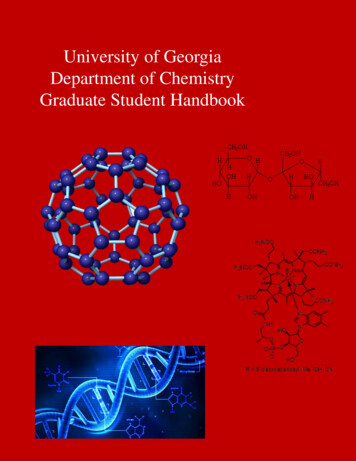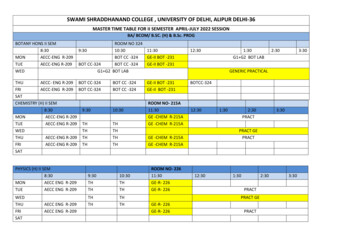
Transcription
1http://chem.ps.uci.edu/ kieron/dft/book/The ABC of DFTKieron Burke and friendsDepartment of Chemistry, University of California, Irvine, CA 92697April 10, 20072
4CONTENTS5.35.45.55.6Correlation . . . . . .Atomic configurationsAtomic densities . . .Questions . . . . . . .49515153ContentsIIIBackground131 Introduction1.1 Importance . . . . . . . . . . . . .1.2 What is a Kohn-Sham calculation?1.3 Reinterpreting molecular orbitals . .1.4 Sampler of applications . . . . . .1.5 Particle in a box . . . . . . . . . .1.6 Questions . . . . . . . . . . . . . .151516192020232 Functionals2.1 What is a functional? . .2.2 Functional derivatives . .2.3 Euler-Lagrange equations2.4 Questions . . . . . . . . .27272830313 One3.13.23.33.43.53.6electronVariational principle .Trial wavefunctions . .Three dimensions . .Differential equationsVirial theorem . . . .Questions . . . . . . .333334353636374 Two electrons4.1 Antisymmetry and spin4.2 Hartree-Fock . . . . . .4.3 Correlation . . . . . . .4.4 Questions . . . . . . . .39393944455 Many electrons5.1 Ground state . . . . . . . . . . . . . . . . . . . . . . . . . . . . . . . . . .5.2 Hartree-Fock . . . . . . . . . . . . . . . . . . . . . . . . . . . . . . . . . .4747483Basics556 Density functional theory6.1 One electron . . . . . . .6.2 Hohenberg-Kohn theorems6.3 Thomas-Fermi . . . . . .6.4 Particles in boxes . . . . .6.5 Questions . . . . . . . . .5757586062637 Kohn-Sham7.1 Kohn-Sham equations7.2 Exchange . . . . . . .7.3 Correlation . . . . . .7.4 Questions . . . . . . .6565676869local density approximationLocal approximations . . . . .Local density approximation .Uniform electron gas . . . . .Questions . . . . . . . . . . .7171727376.777778798010 Properties10.1 Total energies . . . . . . . . . . . . . .10.2 Densities and potentials . . . . . . . . .10.3 Ionization energies and electron affinities10.4 Dissociation energies . . . . . . . . . . .10.5 Geometries and vibrations . . . . . . . .10.6 Transition metals . . . . . . . . . . . . .10.7 Weak bonds . . . . . . . . . . . . . . .81818283858586868 The8.18.28.38.49 Spin9.1 Kohn-Sham equations9.2 Spin scaling . . . . .9.3 LSD . . . . . . . . .9.4 Questions . . . . . . .
5CONTENTS10.8 Gaps . . . . . . . . . . . . . . . . . . . . . . . . . . . . . . . . . . . . . .10.9 Questions . . . . . . . . . . . . . . . . . . . . . . . . . . . . . . . . . . . .IIIAnalysis86868711 Simple exact conditions11.1 Size consistency . . .11.2 One and two electrons11.3 Lieb-Oxford bound . .11.4 Bond breaking . . . .11.5 Uniform limit . . . . .11.6 Questions . . . . . . .89898990909191.12 Scaling12.1 Wavefunctions . . . . . .12.2 Density functionals . . . .12.3 Correlation . . . . . . . .12.4 Correlation inequalities . .12.5 Virial theorem . . . . . .12.6 Kinetic correlation energy12.7 Potential . . . . . . . . .12.8 Questions . . . . . . . . .93. 93. 95. 96. 97. 99. 100. 101. 102. . . . .formula. . . . . . . . . . . . .103103105107109111.11311311311411615 Analysis tools15.1 Enhancement factor . . . . . . . . . . . . . . . . . . . . . . . . . . . . . .15.2 Density analysis . . . . . . . . . . . . . . . . . . . . . . . . . . . . . . . .15.3 Energy density . . . . . . . . . . . . . . . . . . . . . . . . . . . . . . . . .11711711711913 Adiabatic connection13.1 One electron . . . .13.2 Adiabatic connection13.3 Relation to scaling .13.4 Static correlation . .13.5 Questions . . . . . .14 Discontinuities14.1 Koopman’s theorem . . .14.2 Potentials . . . . . . . .14.3 Derivative discontinuities .14.4 Questions . . . . . . . . .6CONTENTS15.4 Questions . . . . . . . . . . . . . . . . . . . . . . . . . . . . . . . . . . . . 11916 Exchange-correlation hole16.1 Density matrices and holes .16.2 Hooke’s atom . . . . . . .16.3 Transferability of holes . . .16.4 Old faithful . . . . . . . . .IV.Beyond LDA17 Gradients17.1 Perimeter problem17.2 Gradient expansion17.3 Gradient analysis .17.4 Questions . . . . .121121125126131135.13713714014214618 Generalized gradient approximation18.1 Fixing holes . . . . . . . . . . . . . . . . . . . . .18.2 Visualizing and understanding gradient corrections .18.3 Effects of gradient corrections . . . . . . . . . . . .18.4 Satisfaction of exact conditions . . . . . . . . . . .18.5 A brief history of GGA’s . . . . . . . . . . . . . . .18.6 Questions about generalized gradient approximations.147147151153154155155.19 Hybrids15719.1 Static, strong, and strict correlation . . . . . . . . . . . . . . . . . . . . . . 15719.2 Mixing exact exchange with GGA . . . . . . . . . . . . . . . . . . . . . . . 15719.3 Questions about adiabatic connection formula and hybrids . . . . . . . . . . 15720 Orbital functionals20.1 Self-interaction corrections . . . .20.2 Optimized potential method . . .20.3 Görling-Levy perturbation theory20.4 Meta GGA’s . . . . . . . . . . .20.5 Jacob’s ladder . . . . . . . . . .VTime-dependent DFT21 Time-dependence.159159159159159159161163
7CONTENTS21.121.221.321.4Schrödinger equation . . . . . . . . . . . . . . . . . .Perturbation theory . . . . . . . . . . . . . . . . . .Optical response . . . . . . . . . . . . . . . . . . . .Questions about time-dependent quantum mechanics .22 Time-dependent density functional theory22.1 Overview . . . . . . . . . . . . . . . . . .22.2 Runge-Gross theorem . . . . . . . . . . .22.3 Kohn-Sham equations . . . . . . . . . . .22.4 Adiabatic approximation . . . . . . . . . .22.5 Questions on general principles of TDDFT.163166169170.17117117317417517623 Linear response17923.1 Dyson-like response equation and the kernel . . . . . . . . . . . . . . . . . 17923.2 Casida’s equations . . . . . . . . . . . . . . . . . . . . . . . . . . . . . . . 18023.3 Single-pole approximation . . . . . . . . . . . . . . . . . . . . . . . . . . . 18124 Performance24.1 Sources of error . . .24.2 Poor potentials . . . .24.3 Transition frequencies24.4 Atoms . . . . . . . .24.5 Molecules . . . . . . .24.6 Strong fields . . . . .18318318318318418418425 Exotica25.1 Currents . . . . . . . . . .25.2 Initial-state dependence . .25.3 Lights, camera, and.Action25.4 Solids . . . . . . . . . . . .25.5 Back to the ground state .25.6 Multiple excitations . . . .25.7 Exact conditions . . . . . .187187187187188188189189.A Math background191A.1 Lagrange multipliers . . . . . . . . . . . . . . . . . . . . . . . . . . . . . . 191A.2 Properties of the δ-function . . . . . . . . . . . . . . . . . . . . . . . . . . 192A.3 Fourier transforms . . . . . . . . . . . . . . . . . . . . . . . . . . . . . . . 1938CONTENTSB Results for simple one-electron systems195B.1 1d H atom . . . . . . . . . . . . . . . . . . . . . . . . . . . . . . . . . . . 195B.2 Harmonic oscillator . . . . . . . . . . . . . . . . . . . . . . . . . . . . . . . 197B.3 H atom . . . . . . . . . . . . . . . . . . . . . . . . . . . . . . . . . . . . . 198C Green’s functions199D Further reading201E Discussion of questions203F Solutions to exercisesF.1 Introduction . . . . . . . .F.2 Functionals . . . . . . . . .F.3 One electron . . . . . . . .F.4 Two electrons . . . . . . .F.5 Many electrons . . . . . . .F.6 Density functional theory .F.7 Kohn-Sham . . . . . . . .F.8 Local density approximationF.9 Spin . . . . . . . . . . . .F.10 Properties . . . . . . . . .F.11 Simple exact conditions . .F.12 Scaling . . . . . . . . . . .G Answers to extra 5
9CONTENTSN" 2i .External potential: V̂ext i! jN"iKohn-Sham: γS (x, x# ) δσσ!vext (ri )WavefunctionsPhysical wavefunction: Ψ[n](x1 .xN ) has density n and minimizes T̂ V̂eeKohn-Sham: Φ[n](x1 .xN ) has density n and minizes T̂"Φ(x1 .xN ) p ( 1)p φ1 (xp1 ).φN (xpN )"Φ(x1 .xN ) p ( 1)p φ1 (xp1 ).φN (xpN )where φi (x) and &i are the i-th KS orbital and energy, with i α, σ.EnergiesUniversal functional: F [n] min%Ψ T̂ Vˆee Ψ& %Ψ[n] T̂ Ψ[n]&Ψ nKinetic energy: T [n] %Ψ[n] T̂ Ψ[n]&.Non-interacting kinetic energy: Ts [n] min%Φ T̂ Φ& %Φ[n] T̂ Φ[n]& Φ nN !"i 1d3 r φi (r) 2Coulomb repulsion energy: Vee [n] %Ψ[n] V̂ee Ψ[n]&.!!Hartree energy: U [n] 12 d3 r d3 r# n(r) n(r# )/ r r# ""! 3 ! 3 # Exchange: EX %Φ Vee Φ& U 12d r d r φiσ (r) φ jσ (r# ) φiσ (r# ) φjσ (r)/ r r# σi,joccKinetic-correlation: TC [n] T [n] TS [n]Potential-correlation: UXC [n] Vee [n] U [n]Exchange-correlation: EXC [n] T [n] TS [n] Vee [n] U [n] %Ψ[n] T̂ Vˆee Ψ[n]& %Φ[n] T̂ Vˆee Φ[n]&Potentials!Functional derivative: F [n δn] F [n] d3 r δn(r) δF [n]/δn(r)Kohn-Sham: vS (r) δTS /δn(r) µ!Hartree: vH (r) δU/δn(r) d3 r# n(r# )/ r r# Exchange-correlation: vext (r) vS (r) vH (r) vXC (r)Densities and density matrices!Spin density: n(x) nσ (r) N dx2 . . . dxN Ψ(x, x2 . . . , xN ) 2 !properties: n(x) 0, dx n(x) N!Density matrix: γ(x, x# ) N dx2 . . . dxN Ψ (x, x2 , . . . , xN )Ψ(x# , x2 , . . . , xN )properties: γ(x, x) n(x), γ(x# , x) γ(x, x# )!kinetic energy: T 12 d3 r 2 γ(r, r# ) r r!Potential energy: V̂ V̂ee V̂ext"Coulomb repulsion: V̂ee 121/ ri rj .i 1CONTENTS!Definitions and notationCoordinatesPosition vector: r (x, y, z), r r .Spin index: σ or α or β.Space-spin vector: x (r, σ).!"! 3drSums: dx σOperatorsKinetic energy: T̂ 1210N"i 1 φi (x) 2N"σi 1φ iσ (r)φiσ (r# )!!Pair Density: P (x, x# ) N (N 1) dx3 . . . dxN Ψ(x, x# , x3 , . . . , xN ) 2!properties: dx# P (x, x# ) (N 1)n(x), P (x# , x) P (x, x# ), P (x, x# ) 0!!potential energy:Vee 12 d3 r d3 r# P (r, r# )/ r r# Kohn-Sham: PX (x, x# ) n(x)n(x# ) γS (x, x# ) 2Exchange-correlation hole around r at coupling constant λ:P λ (r, r u) n(r) [n(r u) nλXC (r, r u)]Kohn-Sham: nX (x, x# ) γS (x, x# ) 2 /n(x)!!properties: nX (r, r u) 0, d3 u nX (r, r u) 1, d3 u nλC (r, r u) 0Pair correlation function: g λ (x, x# ) P λ (x, x# )/(n(x)n(x# ))Electron-electron cusp condition: dg λ (r, u)/du u 0 λg λ (r, u 0)Uniform coordinate scalingDensity: n(r) nγ (r) γ 3 n(γr)Wavefunction: Ψγ (r1 . . . rN ) γ 3N/2 Ψ(γr1 . . . γrN )Ground states: Φ[nγ ] Φγ [n], but Ψ[nγ ] * Ψγ [n]Fundamental inequality: F [nγ ] γ 2 T [n] γVee [n]Non-interacting kinetic energy: TS [nγ ] γ 2 TS [n]Exchange and Hartree energies: EX [nγ ] γEX [n], U [nγ ] γU [n]Kinetic and potential: T [nγ ] γ 2 T [n], Vee [nγ ] γVee [n](γ 1)Correlation energies: EC [nγ ] γEC [n], TC [nγ ] γ 2 TC [n](γ 1)Virial theorem: 2T %r · V̂ &!N electrons: 2T Vee d3 r n(r) r · vext (r)! 3XC: EXC TC d r n(r) r · vXC (r)Spin scalingKinetic: TS [n , n ] 12 (TS [2n ] TS [2n ])Exchange: EX [n , n ] 12 (EX [2n ] EX [2n ])Adiabatic connection!Hellmann-Feynman: E E λ 0 01 dλ%Ψλ dH λ /dλ Ψλ &Wavefunction: Ψλ [n] has density n and mininimizes T̂ λV̂ee ;relation to scaling: Ψλ [n] Ψλ [n1/λ ]Energies: E λ [n] λ2 E[n1/λ ]kinetic: TSλ [n] TS [n][n]exchange: EXλ [n] λEX [n], U λ [n] λU# (2)(3)correlation: ECλ [n] λ2 EC [n1/λ ] λ2 EC [n] λES [n] . . . for small λACF: EXC !10 dλλUXC (λ), where UXC (λ) UXC/λ
CONTENTS11Finite systemsKato’s cusp at nucleus: dn/dr r Rα 2Zα n(Rα ) % "Large r in Coulombic system: n(r) Ar β e 2Ir , β α Zα N 1/ 2IExchange potential: vX (r) 1/rCorrelation potential: vC (r) α(N 1)/2r 4 , where α(N 1) is the polarizability of theN 1 electron system.!Von-Weisacker: TSVW [n] d3 r n 2 /(8n) (exact for N 1, 2)Exchange: EX U/N for N 1, 2Correlation: EC 0 for N 1(2)(3)High-density limit: EC [nγ ] EC [n] EC [n]/γ . . . as γ 3/2Low-density limit: EC [nγ ] γB[n] γ C[n] . . . as γ 0.Uniform gas and LSDMeasures of the local density Wigner-Seitz radius: rs (r) (3/(4πn(r))1/313Fermi wave vector: kF (r) (3π 2 n(r))%Thomas-Fermi wavevector: ks (r) 4kF (r)/πMeasure of the local spin-polarization:Relative polarization: ζ(r) (n (r) n (r))/n(r)(n) (3/10)kF2 (n)nKinetic energy: tunifSexchange energy: eunif(n) n&unif(n), where &unif(n) (3kF (n)/4π),XXX(r) 0.0311lnr 0.047 0.009rs ln rs 0.017rs(rs 0)correlation energy: &unifssC!Thomas-Fermi: TSTF [n] AS d3 r n5/3 (r) where As 2.871.!LSD: EXLDA [n] AX d3 r n4/3 (r) where AX (3/4)(3/π)1/3 0.738.! 3LSD(rs (r), ζ(r)EC [n , n ] d r n(r)&unifCGradient expansions&'!Gradient expansion: A[n] d3 r a(n(r)) b(n(r) n(r) 2 . . .Gradient expansion approximation: AGEA [n] ALDA [n] AGEA [n]Reduced density gradient: s(r) n(r) /(2kF (r)n(r)Correlation gradient: t(r) n(r) /(2ks (r)n(r) ζ)2/3 )/2Polarization enhancement: φ(ζ) ((1( ζ)2/3 (1)!2Kinetic energy: TS [n] AS d3 r n5/3 1 5s/27or T GEA [n] T VW [n]/9.() S! 3Exchange energy: EX [n] AX d r n4/3 1 10s2 /81!High-density correlation energy: ECGEA (2/3π 2 ) d3 r n(r)φ(ζ(r))t2 (r)! 3GGA[n] d r a(n, n )Generalized gradient approximation: A!GGA d3 r eunif(n(r))FXC (rs (r), s(r))Enhancement factor: EXCX12CONTENTS
Part IBackground13
16Chapter 1IntroductionIn which we introduce some of the basic concepts of modern density functional theory,including the Kohn-Sham description of a system, and give a simple but powerful exampleof DFT at work.1.1Importance1Density functional theory (DFT) has long been the mainstay of electronic structure calculations in solid-state physics. In the 19990’s it became very popular in quantum chemistry. Thisis because approximate functionals were shown to provide a useful balance between accuracyand computational cost. This allowed much larger systems to be treated than by traditionalab initio methods, while retaining much of their accuracy. Nowadays, traditional wavefunction methods, either variational or perturbative, can be applied to find highly accurate resultson smaller systems, providing benchmarks for developing density functionals, which can thenbe applied to much larger systemsBut DFT is not just another way of solving the Schrödinger equation. Nor is it simply amethod of parametrizing empirical results. Density functional theory is a completely different,formally rigorous, way of approaching any interacting problem, by mapping it exactly to amuch easier-to-solve non-interacting problem. Its methodology is applied in a large variety offields to many different problems, with the ground-state electronic structure problem simplybeing the most common.The aim of this book is to provide a relatively gentle, but nonetheless rigorous, introductionto this subject. The technical level is no higher than any graduate quantum course, or manyadvanced undergraduate courses, but leaps at the conceptual level are required. These arealmost as large as those in going from classical to quantum mechanics. In some sense, theyare more difficult, as these leaps are usually made when we are more advanced (i.e., set) inour thinking.Students from all areas of modern computational science (chemistry, physics, materialsscience, biochemistry, geophysics, etc.) are invited to work through the material. The only1 !2000cby Kieron Burke. All rights reserved.15CHAPTER 1. INTRODUCTIONnecessary requirements are a good background in elementary quantum mechanics, no fearof calculus of more than one variable, and a desire to learn. The student should end upknowing what the Kohn-Sham equations are, what functionals are, how much (or little) isknown of their exact properties, how they can be approximated, and how insight into all thesethings produces understanding of the errors in electronic structure calculations. Preliminaryforms of my lecture notes have been used throughout the world during 5 years its taken tocomplete this book. The hope is that these notes will be used by students worldwide to gaina better understanding of this fundamental theory. I ask only that you send me an email (tokieron@rutchem.rutgers.edu) if you use this material. In return, I am happy to grade problemsand answer questions for all who are interested. These notes are copyright of Kieron Burke.No reproduction for purposes of sale is allowed.The book is laid out in the form of an undergraduate text, and requires the working ofmany exercises (although many of the answers are given). The idea is that the book andexercises should be easy reading, but leave the reader with very clear concepts of moderndensity functional theory. Throughout the text, there are exercises that must be performedto get full value from the book. Also, at the end of each chapter, there are questions aimedat making you think about the material. These should be thought about and answere as yougo along, but answers don’t need to be written out as explicitly as for the problems.1.2What is a Kohn-Sham calculation?To give an idea of what DFT is all about, and why it is so useful, we start with a very simpleexample, the hydrogen molecule, H2 . Throughout this book, we make the Born-Oppenheimerapproximation, in which we treat the heavy nuclei as fixed points, and we want only to solvethe ground-state quantum mechanical problem for the electrons.In regular quantum mechanics, we must solve the interacting Schrödinger equation: 1 - 21 i vext (ri ) Ψ(r1 , r2 ) EΨ(r1 , r2 ), 2 r r 12i 1,2i 1,2(1.1)where the index i runs over the two electrons, and the external potential, the potentialexperienced by the electrons due to the nuclei, isvext (r) Z/r Z/ r Rẑ ,(1.2)where Z 1 is the charge on each nucleus, ẑ is a unit vector along the bond axis, and R isa chosen internuclear separation. Except where noted, we use atomic units throughout thistext, so thate2 h̄ m 1,(1.3)where e is the electronic charge, h̄ is Planck’s constant, and m is the electronic mass. Asa consequence, all energies are in Hartrees (1 H 27.2114 eV 627.5 kcal/mol) and all
171.2. WHAT IS A KOHN-SHAM CALCULATION?E(H2 ) 1/R-E(2H) (kcal/mol)distances are given in Bohr radii (ao 0.529Å). In this example, the electrons are in aspin singlet, so that their spatial wavefunction Ψ(r1 , r2 ) is symmetric under interchange ofr1 and r2 . Solution of Eq. (1.1) is complicated by the electrostatic repulsion between theparticles, which we denote as Vee . It couples the two coordinates together, making Eq. (1.1)a complicated partial differential equation in 6 coordinates, and its exact solution can be quitedemanding. In Fig. 1.1 we plot the results of such a calculation for the total energy of themolecule, E 1/R, the second term being the Coulomb repulsion of the nuclei. The positionof the minimum is the equilibrium bond length, while the depth of the minimum, minus thezero point vibrational energy, is the bond energy. More generally, the global energy minimumdetermines all the geometry of a molecule, or the lattice structure of a solid, as well as all thevibrations and rotations. But for larger systems with N electrons, the wavefunction dependson all 3N coordinates of those 1.41.6R(Å)Figure 1.1: The total energy of the H2 molecule as a function of internuclear separation.We note at this point that, with an exact ground-state wavefunction, it is easy to calculatethe probability density of the system:n(r) 21d3 r# Ψ(r, r# ) 2 .(1.4)The probability density tells you that the probability of finding an electron in d 3 r around r isn(r)d3 r. For our H2 molecule at equilibrium, this would look like the familiar two decayingexponentials centered over the nuceli, with an enhancement in between, where the chemicalbond has formed.Next, imagine a system of two non-interacting electrons in some potential, v S (r), chosensomehow to mimic the true electronic system. Because the electrons are non-interacting,their coordinates decouple, and their wavefunction is a simple product of one-electron wavefunctions, called orbitals, satisfying:231 2 vS (r) φi (r) &i φi (r),2(1.5)18CHAPTER 1. INTRODUCTIONwhere Φ(r1 , r2 ) φ0 (r1 )φ0 (r2 ). This is a much simpler set of equations to solve, since itonly has 3 coordinates. Even with many electrons, say N , one would still need to solve onlya 3-D equation, and then occupy the first N/2 levels, as opposed to solving a 3N -coordinateSchrödinger equation. If we can get our non-interacting system to accurately ’mimic’ thetrue system, then we will have a computationally much more tractable problem to solve.How do we get this mimicking? Traditionally, if we think of approximating the true wavefunction by a non-interacting product of orbitals, and then minimize the energy, we find theHartree-Fock equations, which yield an effective potential: 2vSHF (r) vext (r) 1 1 3 # n(r# ).dr2 r r# (1.6)The correction to the external potential mimics the effect of the second electron, in particularscreening the nuclei. For example, at large distances from the molecule, this potential decaysas 1/r, reflecting an effective charge of Z 1. Note that insertion of this potential intoEq. (1.5) now yields a potential that depends on the electronic density, which in turn iscalculated from the solution to the equation. This is termed therefore a self-consistent setof equations. An initial guess might be made for the potential, the eigenvalue problem isthen solved, the density calculated, and a new potential found. These steps are repeateduntil there is no change in the output from one cycle to the next – self-consistency has beenreached. Such a set of equations are often called self-consistent field (SCF) equations. InFig. 1.1, we plot the Hartree-Fock result and find that, although its minimum position is veryaccurate, it underbinds the molecule significantly. This has been a well-known deficiency ofthis method, and traditional methods attempt to improve the wavefunction to get a betterenergy. The missing piece of energy is called the correlation energy.In a Kohn-Sham calculation, the basic steps are very much the same, but the logic isentirely different. Imagine a pair of non-interacting electrons which have precisely the samedensity n(r) as the physical system. This is the Kohn-Sham system, and using densityfunctional methods, one can derive its potential vS (r) if one knows how the total energyE depends on the density. A single simple approximation for the unknown dependence ofthe energy on the density can be applied to all electronic systems, and predicts both theenergy and the self-consistent potential for the fictitious non-interacting electrons. In thisview, the Kohn-Sham wavefunction of orbitals is not considered an approximation to theexact wavefunction. Rather it is a precisely-defined property of any electronic system, whichis determined uniquely by the density. To emphasize this point, consider our H2 example inthe united atom limit, i.e., He. In Fig. 1.2, a highly accurate many-body wavefunction forthe He atom was calculated, and the density extracted. In the bottom of the figure, we plotboth the physical external potential, 2/r, and the exact Kohn-Sham potential. 3 Two noninteracting electrons sitting in this potential have precisely the same density as the interacting2 For the well-informed, we note that the correction to the external potential consists of the Hartree potential, which is double that shown above,less the exchange potential, which in this case cancels exactly half the Hartree.3 It is a simple exercise to extract the exact Kohn-Sham potential from the exact density, as in section ?.
1.3. REINTERPRETING MOLECULAR ORBITALS1920CHAPTER 1. INTRODUCTION4!2density0-2Kohn-Sham potential-4-2/r1s1s1s!-6He atom-800.20.4r0.60.81Figure 1.2: The external and Kohn-Sham potentials for the He atom, thanks to Cyrus’ Umrigar’s very accurate density.Figure 1.3: Orbital diagram of H2 bond formation.electrons. If we can figure out some way to approximate this potential accurately, we havea much less demanding set of equations to solve than those of the true system. Thus weare always trying to improve a non-interacting calculation of a non-interacting wavefunction,rather than that of the full physical system. In Fig. 1.1 there are also plotted the localdensity approximation (LDA) and generalized gradient approximation (GGA) curves. LDAis the simplest possible density functional approximation, and it already greatly improves onHF, although it typically overbinds by about 1/20 of a Hartree (or 1 eV or 30 kcal/mol),which is too inaccurate for most quantum chemical purposes, but sufficiently reliable for manysolid-state calculations. More sophisticated GGA’s (and hybrids) reduce the typical error inLDA by about a factor of 5 (or more), making DFT a very useful tool in quantum chemistry.In section 1.5, we show how density functionals work with a simple example from elementaryquantum mechanics.And a highly accurate approximate density functional calculation produces the full electronicenergy from these orbitals, resolving the paradox.1.31.5Reinterpreting molecular orbitalsThe process of bonding between molecules is shown in introductory chemistry textbooks aslinear combinations of atomic orbitals forming molecular orbitals of lower energy, as in Fig.1.3.But later, in studying computational chemistry, we discover this is only the Hartree-Fockpicture, which, as stated above, is rarely accurate enough for quantum chemical calculations.In this picture, we need a more accurate wavefunction, but then lose this simple picture ofchemical bonding. This is a paradox, as chemical reactivity is usually thought of in terms offrontier orbitals.In the Kohn-Sham approach, the orbitals are exact and unique, i.e., there exists (at most)one external potential that, when doubly occupied by two non-interacting electrons, yieldsthe exact density of the H2 molecule. So in this view, molecular orbital pictures retain theirsignificance, if they are the exact Kohn-Sham orbitals, rather than those of Hartree-Fock.1.4Sampler of applicationsIn this section, we highlight a few recent applications of modern DFT, to give the reader afeeling for what kinds of systems can be tackled.Example from biochemistry, using ONIOM.Example from solid-state, eg ferromagnetism.Example using CP molecular dynamics, eg phase-diagram of C.Example from photochemistry, using TDDFT.Particle in a boxIn this section, we take the simplest example from elementary quantum mechanics, and applydensity functional theory to it. This provides the underlying concepts behind what is goingon in the more previous sections of this chapter. Much of the rest of the book is spentconnecting these two.In general, we write our Hamiltonian asĤ T̂ V̂(1.7)where T̂ denotes the operator for the kinetic energy and V̂ the potential energy. We beginwith the simplest possible case. The Hamiltonian for a 1-D 1-electron system can be writtenas1 d2 V (x)(1.8)Ĥ 2 dx2
211.5. PARTICLE IN A BOXThe time-independent Schrödinger equation has solutions:Ĥφi εi φi ,i 0, 1, .(1.9)Thus ε0 denotes the ground state energy and φ0 the ground state wave function. Becausethe operator Ĥ is hermitian the eigenstates can be chosen orthonor
C o n t en t s I B a c k g ro u n d 1 3 1 I n tro d u c ti on 15 1 .1 Imp o r t a nce . . . . . . . . . . . . . . . . . . . . . . . . . . . . . . . . . . . 1 5











